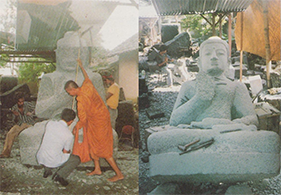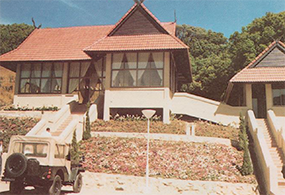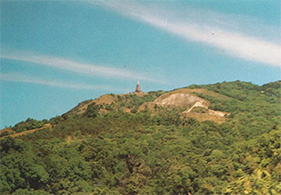

The Great Holy Relics Pagoda


From the sky down upon the land
In the occasion that RTAF has turned 72th on March 27, 1987 and His Majesty the King Bhumibol shall have his 60 years old birthday anniversary on December 5th, the same year. RTAF officers by Air Chief Marshal Prapan Thupatemi, Commander-in- Chief, and the high level officers mutually agreed to donate money to build a structure in commemoration to this auspicious occasion of RTAF and presented such building as a royal charity to His Majesty the King.
The structure to be built under this donation must be great enough to celebrate the great anniversary of His Majesty the King’s 60 years-old anniversary and to announce his greatness that he will reign the throne longer than the other kings in our history on the July 2, 1988.
To build the pagoda which shall be dedicated as the royal merit to His Majesty the King whose mercy is greater than the land and the sky must be located at the highest point of Thailand that RTAF could manage to build. The mercy, the grace and the holiness of His Majesty the King shall be located at the highest point of Thailand and in the hearts of all walk of lives of Thai people.
RTAF has chosen one peak of Intanon Mountain, the highest mountain in Thailand, as the location to build the pagoda. Later on, His Majesty the King has granted the name, as requested by RTAF, as “The Great Holy Relics Pagoda Nabhamethanidol” which means the great holy relics pagoda of which mightiness extending from the sky down upon the land.

In 1977, Air Chief Marshal Prapan Thupatemi, Commander-In-Chief at that moment, initiated to build pagoda at Intanon Mountain in order to contain the received Buddha Relics and to allow all Buddhists to pay respect to. He discussed with Air Marshal Woranart Abhijari, Deputy Chief of the Air Staff (rank and position at that moment) to find a proper location for construction.
At the end of November 1985, Air Marshal Woranart together with Air Vice Marshal Prasert Satchukorn (worked at RTAF headquarter), Group Captain Prasart Thaweesuk (Head of Map and Land Division, Directorate of Logistics)
and 2 engineers under the Ministry of Public Health, Mrs. Khaisri Tansiri and Mr. Santi Chayasombat, have surveyed many locations for the construction. In this regard, Group Captain Watchara Yuktanan, Commander of Inthanon Mountain Control and Report Center at that time, led the survey to the chosen location which believed that it was proper in term of landscape and the convenience for Buddhists to travel by using Chomtong-Intanon road to visit and pay respect to the pagoda.
The survey team has chosen 2 locations at the summit of a hill which lays in line on the left of Chomtong-Intanon road, around k.m.41. The first location is on the lower end of the summit. If built the pagoda here, it would be good because we could see the pagodas from afar yet the location is very close to the road. Unfortunately, the area is quite steep and narrow so the space for building the pagodas is limited. Thus, the survey team reconsidered the second location which is in the same ridge but located up higher and not too far from the road. The team has chosen the second location and requested Map and Land Division, Directorate of Logistics, to send its staffs to further study in details.
After survey in details, the survey team led by Air Marshal Woranart has chosen the area at latitude 18-33N, longitude 98-29E and altitude 2,146 meters from average sea level. (around 7 kilometers from Inthanon Mountain Control and Report Center or around the 41.528 th Km. of Chomtong-Intanon road, 200 meters from the left side of the road)
The survey team has divided job into 2 parts; one is to collect information in order to request for the permission to make use of such location from the Royal Forest Department, another is to collect information to use in conceptual design of construction, roads, bridges and parking lot. The survey took many days. The survey teams had to travel through deep forest, mountains, crossed the rivers with difficulty and completed the jobs in January 1986. (Except the location for building the bridge and the Pagoda for they have to coring the ground to design the foundation. This was done in July 1986.)
The survey team which led by Air Marshal Woranart decided to choose this location to build the Pagoda wished by the Commander-In- Chief because it’s scenery support the pagodas, easy for Buddhists to visit and pay respect to the Buddha Relics and the most important reason was it has not much affected to the environment, water resources, and brook in the national park area. Later on, Air Chief Marshal Prapan Thupatemi, Commander-In- Chief, has approved the idea and assigned the survey team to further request for the permission from the Royal Forest Department. The Directorate of Civil Engineering has started to design lay out on road and parking lot and its cost together with a study on cost of site preparation. Those works were completed in March 1986.
In order to build the holy pagoda within an area of the National Park, RTAF must request for permission from the National Park Committee first. In this case, RTAF has sent a letter dated February 10, 1986 to the Director General of the Royal Forest Department requested to allow RTAF to use the chosen location to build the Pagoda, its bridge, road and parking lot in the total area around 18 Rai, 2 Ngarn and 45 square wah (around 7.0 acres).
The Royal Forest Department has forwarded this issue to its branch in Chiang Mai to check the information. Then will report to the National Park Committee for further approval. After received the required information, the Royal Forest Department took the issue to discuss with the National Park Committee in the 3/1986 conference dated July 17, 1986. The committee approved concept and let RTAF proceed with the construction at the chosen location. RTAF has sent additional comments, explanations and information to the Royal Forest Department on September 5, 1986.
After that, RTAF has issued a letter dated October 24, 1986 enclosed with Environment Impact Assessment (EIA) of the project to the secretary of the National Environment Board. The board has informed the Director General of the Royal Forest Department on January 20, 1987 that they approved the EIA of which have proposed plan to prevent and reduce environmental impact as well as monitoring method.
The Ministry of Agriculture and Cooperatives has considered and approved resolutions from the National Park Committee, suggestions from the Royal Forest Department and resolution from the Ministry of Agriculture and Cooperatives itself to allow RTAF to utilize the chosen location at Intanon National Park to build the pagoda. RTAF could proceed for further action.

At first, RTAF Commander-In- Chief has initiated to build Pagoda in average size. He had set up a working group to work on this project on April 7, 1986. Anyway, after sent the team to start ground work, around the end of October, 1986, RTAF has reconsidered that His Majesty the King Bhumibol, the Generalissimo, would reach 60 years old in December 1987 and also RTAF would reach its 72 years anniversary on March 27, 1987, this should be the auspicious occasion to gather faith and unity of RTAF people to donate to build this Pagoda extraordinarily and present it to His Majesty the King. The pagoda, in later on, was built from many objectives as follows:
- 1. To present as the royal charity in commemoration of His Majesty the King Bhumibol’s 60th birthday anniversary.
- 2. To build a permanent structure on the occasion that RTAF has reached 72 years anniversary in 1987.
- 3. To build a shrine to praise and to support the existence of Buddhism.
- 4. To create new tourism attraction within the National Park to persuade tourists to visit.
- 5. To represent the faith of soldiers and citizens toward their Generalissimo and their king.
RTAF has proceeded with this project until certain that the responsible officers and government agencies outside RTAF could cooperate to push this project to be completed without any obstructions. Even though there was no official letter to confirm at that time, RTAF could foresee that the time span for construction and management on things to be completed before the kings’ 60 th years old celebration was limited, so they rushed sending 17 officers from the Civil Engineering Department, led by Group Captain Sombat Sukonthong, with machinery into the chosen location on May 1986 without publish any news to RTAF officers or the public.
- The officers have set up a camp at the 31 st kilometer of Chomtong-Intanon road. They have 1 of bulldozer, grader, excavator, sheep foot roller, smooth wheel roller and pay loader and 2 dump trucks. 8 machinery in total.
- This pioneer could excavate and leveling the land that will use to build the pagoda around July 18th, 1986. Details of the difficulties will be described in the next chapter.
Since RTAF has initiated to build the Pagoda to contain Lord Buddha Relics at Intanon Mountain in late 1985, RTAF has prepared and planned the work in accordance with the involved conditions and has solved many problems respectively. We have sent a pioneer team into the chosen location in May 1986 for 7-8 months to excavate and leveling the land to seriously meet the objectives of this project.
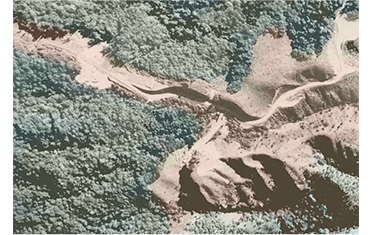
RTAF has set up a steering committee to take care of this project on November 13, 1986 by having Air Chief Marshal Woranart Abhijari, Deputy Commander-in-Chief, as a chairman. In the same time, RTAF have set up 3 more subcommittees which are; Fund Raising Subcommittee having Air Marshal Weera Kijjatorn, Assistant Chief of staff, Intelligence Corp., as the chairman ;and Construction and Decoration Control Subcommittee having Air Marshal Krerkchai Harnsongkram, Director of Education and Training, as the chairman. The Steering Committee and Subcommittees have started their work in accordance with the road map since late 1986s onward.
Besides the above, RTAF has issued a letter dated December 12, 1986 to the Chairman of Government Sector, under the Board of the Celebration on the Auspicious Occasion of His Majesty the King Bhumibol to request for a permission to build the Pagoda as part of the celebration. The Chairman of the Board of the Celebration on the Auspicious Occasion of His Majesty the King Bhumibol has approved the project on June 30, 1987.
It was once in a blue moon that the key institutions of the nation would have the auspicious anniversary in the same year. This was hard to happen and have to wait for a very long time. When such occasion emerged, we have not let it pass worthlessly but gathering little by little from our faith and unity until we could build something grand at Intanon Mountain as a bless of peace and happiness to the Kingdom of Thailand and praise the greatness of our king to all place over the world. This merit is far beyond our intelligence to think that when we could have such great opportunity to be united to do something like this to present to our King again.
Site Preparation on Land, Parking lot and Bridge
Upon the first 17 staffs, led by Group Captain Sombat Sukhontong and with 8 heavy machinery, have reached the construction camp at the 31th Kilometer of Chomtong-Intanon road, they have started their work immediately.
Group Captain Sombat has described about his works as follows;





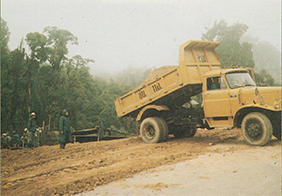






“Around early of May 1986, Directorate of Civil Engineering was assigned to build road, parking lot and prepare the location to which the Pagoda will be built. So we move our officers and machinery in and set up a construction camp at Highway Station, the 21th Kilometer of Chomtong-Intanon road. The maneuver was completed around May 20, 1986. The officers have started their work promptly. The resources and machinery that we have are as follows;
List of Machinery:
- 1 Bulldozer
- 1 Grader
- 1 Excavator
- 1 Sheep Foot Roller
- 1 Roller
- 1 Pay Loader
- 2 Dump Trucks
Before started our work, my team and I (Group Captain Sombat) have made a worship ritual to the guardian spirit of the mountain and the forest, especially to the shrine of Intanon Mountain’s holy guardian (the late King Indrarawitchayanon) and the shrine of Director Kiat Mankalapruk (Air Marshal Kiat Mankalapruk, passed away from helicopter crashed at Intanon Mountain) as a traditional ritual when need to cut down trees in the forest.
Details of the road to the Pagoda is around 175 meters in length and 4 meters in width. Pavement of each side of the road is 1 meter in width and paved with DBST-type asphaltic concrete. Parking lot space is 40x40 meters and also paved with DBST-type asphaltic concrete. The road shall have to lead into deep forest and brooks. It started from Chomtong-Intanon road at the 4.1.500th kilometer and led to the left until end at the hill. There is a steep slope but we need to find the way to take our bulldozer up to the top of the hill so that we can grade the land at the chosen location. To build a road at the mountain, it is necessary that we grade the land from the top to the bottom.
The way up to the hill was very steep and cut through the brook, so we have to build a temporary road because the bulldozer cannot climb up by itself. Anyway, to build such temporary road through the brook and cut through the hill was also very difficult because the soil there was full of leaves and covered with rotten grasses. When the bulldozer climbed up for a bit it slided down. Unlucky that that time was the beginning of a rainy season. In rainy days, we have to stop working. Thus, it took us almost 2 weeks to finish building this temporary road (from May 15 to June 1, 1986). We could fully start to grade the land at the chosen location on June 2, 1986.
This hill has no trees (assumed that the hill tribe has cut down the trees and use the land to plant opium). It is around 2,146 meters above mean sea level and around 40 meters higher from Chomtong-Intanon road. The space is around 8,000 square meters. We have to cut about 6 meters deep to make the ground even enough for building the Pagoda.
The Pagoda shall be built at the front side of the hill so that we can see beautiful scenery either from Mae Jam District or from Chomtong District of Chiang Mai. Likewise, when we are on Chomtong-Intanon road around the 38.50th kilometer and look up, we could see this hill clearly. That is why they chose this area.
Grading land on this hill was very difficult because it was raining every day in June and the wind blew so strong around 40-50 knots all the times. Our staffs need to wear jackets all day because of mist. When it rained, they have to hide under the shelter they built. To use Bulldozer here, I was also afraid of having accident. When the bulldozer ran out of gas, we have to let our porters go down the hill and carry the gallon of gas from the road up here because the temporary road was too slippery. We could not drive the bulldozer down.
There is one time, when the bulldozer driver (Mr. Prasit Rermnoi) was grading land, my staff and I (AC. Sombat) were at the site to monitor and control because we were afraid the accident would happen but it still happened. It was when I walked away to explain details of the work to other staffs, when I turned back I found that the bulldozer was almost failed into the chasm on Mae Jam District side. It was because the soil wet and the bulldozer was so heavy. When we used it near the edge, it made the soil slide down. Fortunately the driver could use the bulldozer’s blade and ripper to hold the machine back in time. At that moment, it was going to rain soon and I felt uncomfortable because if it rain, land could slide and the bulldozer might fall down again. This bulldozer costs 3.5 million baht. If it failed down, I might have ended my career.
I could only pray to all the guardian spirits all the time and tried to use other machine to pull that bulldozer back. Even though the machine is smaller than the bulldozer but it could pull the bulldozer back just like miracle and seems like the bulldozer would not fall down again. It was such a relief. I put my hands together and raised over my head to worship Intanon Mountain guardian spirits. After that we worked more carefully until the job was done around July 18, 1986. It took around 2 months but the actual working time is only 2 weeks because there were so many obstructers from weather and other causes.
When finished grading the area at top of the hill where the Pagoda will be built, we continued to grade the area for building parking lot and road. At that time, it was the middle of rainy season and it has rained almost every days. We could not fully work. Though there was no rain but the sky would cloudy. Mist and thick fog covered all over the area all the time. The fog was so thick that we could not see each other even though we stayed only 10 meters away from each other. We continued working until September 1986 that ground grading work was completed. We completed the crushed rocks work and applied asphalt work, then the road was ready to passage (if it didn’t rain).
At that time, the bridge design was done and the budget was already allocated, so we have to start to work on the bridge. We have cleared the area and dig the first footing on October 4, 1986. I need to change some staffs of the team for I need plasterers, carpenters and smiths to do this job.
สThis bridge is made of reinforced concrete with 36 meters in length and 6 meters in width. There are pavements at 1 meter length at each side. The bridge was divided into 3 parts. The first and the last part are 3 meters in length while the middle part is 16 meters in length. There was no piles used at foundation but we used spread footings laid on rocks which are about 3-4 meters deep. Its height is about 12 meters from the ground of the brook to the bridge.
This construction used about 10 technicians, 12 labors and 25 foremen. The work started from 7.30 a.m. until 5.00 p.m. Sometimes might finished late until 8.00 p.m. There was light rain during this work but was not obstructed us. We started digging the first footing, poured concrete and built the column to support the bridge. We have made it from the 1st footing, the 2nd, the 3rd until the 4th or the last one. After finish excavation for footings, we laid iron grates to reinforce the footings. These iron grates were already well tied and it needed about 8 people to carry, so we used the excavator to do this job instead. It was still difficult to lift because the iron grates were 2.5 meters in width and 7 meters in length. It would swing if we had not control it well enough because the excavator’s boom is high and we used sling to hang the iron grates. I assigned Flight Lieutenant Soontorn and other staffs to work together until it was done and move it to lay at the footings beds which were around 20 meters away.
While the excavator was working, FL. Soontorn need to be away to assign jobs in other zone and I was also took care of another zone, it turned out that the iron grate swung too much. So the excavator driver stopped to move in order to make the iron grate stop swinging and would move on later. But the iron grate still not stop swinging. The smith (Mr. Samnao Pantuan) had jumped down to grab the iron grate hoping to stop it from swinging. But the area he jumped is a slope so he failed down while the excavator was moving. So it ran over half of his body and many people screamed out loud. The excavator moved back. I suddenly rushed from where I was to check him. I saw his face so pale. (I was so frightened and thought that we came to make merit but it might have turned out to commit a sin. Anyway, I still believed and prayed to Intanon Mountain guardian spirits all the times.) Then we moved him to Intanon Mountain Control and Report Center for first aid. Then we moved him to check and to receive x-ray at Chomtong hospital. It turned out that only his coccyx that dislocated and there was no other injury. (I was so relieved.) However, he had to rest about 1 month to let coccyx bone back to its location. I let him rest at Chiang Mai hospital until he recovered and I sent him back home. I always think that building the Pagoda is a real making merit. Both accidents occurred had no injury.
Bridge building work had continued until the foundation was done on November 25, 1986. We had continued our work with the bridge deck, pavements and other parts until finished and opened on December 29, 1986. The bridge costs 1,923,593 baht in total.
After finished building the bridge, we were back to continue building the unfinished road and parking lot by re-leveling the base soil until paved with DBST-type (Double Bituminous Surface Treatment) asphalt. We have built concrete drainage along 2 sides of the road. All were done on January 20, 1987. It costs 395,669 baht. Total cost for building the road, the parking lot and the bridge is 2,619,162 baht (Baht: Two million six hundred nineteen thousand and one hundred sixty two only). After that, have moved manpower and machinery out on January 6, 1987. So everything was done within timeframe and could open to use with no problem.”
The Great Holy Relics Pagoda Nabhamethanidol
Architect who designed the Pagoda.When ACM Woranart Abhijari was in charge as head of the survey team of RTAF to survey the chosen area in November 1985, he had invited Mrs. Khaisri Tansiri and Mr. Santi Chomsombat, 2 architects under the Ministry of Public Health, to join his team. He chose these 2 architects to join this project because they are knowledgeable and reliable as they have designed many shrines in Buddhism such as Venerable Mun Bhuridatta Museum at Sutthawas Forest Monastery, Muang District, Sakon Nakhon Province, Venerable Fan Ajaro Memorial at Udomsomporn Forest Monastery, Phanna Nikhom District, Sakon Nakhon Province and Chapel at Doi Mae Pang temple, Phrao District, Chiang Mai Province.
Mrs. Khaisri Tansiri, Director of Design and Construction Division, the Ministry of Public Health, had chosen Mr. Santi Chayasombat, Architect Level 6, Design and Construction Division, the Ministry of Public Health, to be a Co-Architect and had chosen Mr. Kanjak Satapanasoot, Engineer Level 7, Design and Construction Division, the Ministry of Public Health, to be the main engineer in this project. These 3 officers had accepted to work in this project with pleasure and gladly work for free. They started their work from site survey, construction design, structural calculation, project monitoring, and problem solving since the first concept until enlarge into big pagoda.
To design the pagoda, architects and engineer have divided the job into 2 parts, structure and decoration. The structural construction shall take 285 days and costs about 17.5 million baht. The decoration part shall take 240 days and costs about 24 million baht. Ideally, they aimed that both parts shall be completed before His Majesty the King’s 5 th Cycle Birthday Anniversary on December 5, 1987.
The key idea is to build the pagoda with the height from top to base, parking lot level or ground level, at 60 meters to represent the auspicious occasion of His Majesty the King Bhumibol’s 60th birthday.
Shape of the pagoda represent the Lord Buddha and his enlightenment as well as the other parts shall show about his past lives and biography. The shape and lines were designed in the strong and stable fashion yet provided elegant-look like the calm soldier. The architects had designed the pagoda’s shape in octagon bell shape to represent the attempts of the Lord Buddha in searching for the supreme truth of which was spread out all over the world just like sound of the bell. The architects used straight lines to create edges to give the feeling of steadiness. Shape of the pagoda is different from the ancient art both in the northern of Thailand and in the central of Thailand. It is a new architecture to be built at the highest spot of Thailand.

Body of the pagoda is in octagon bell shape divided into 3 parts to represent Lord Buddha’s great 3 Completeness that he had practiced. The 10 Ordinary Completeness represented at the bottom, the 10 Superior Completeness at the middle and the Supreme Completeness at the upper part of the bell. When he had completed all of these, then it is called 30 Completeness.
Above the bell shape is a lotus shape with 8 petals represents the Noble 8-Fold Path.
Top of the pagoda was designed in a shape like banana blossom to represent the Lord Buddha’s enlightenment and nirvana. At the top installed a 9-tiers silver Chatra.
The pagoda’s base was designed in 2 levels of big terraces encircled the pagoda. It represents the steadiness which is a foundation of the Great Completeness. These big terraces enhance the pagoda to look more beautiful and can be used by Buddhists to do clockwise spiritual act of merit or standing to view scenery surround Intanon Mountain. This terraces are called Prataksin terrace.
At the 2 terraces, there are arches showing Dan Kwian Low-Relief Art, 7 at the lower terrace and 6 at the upper terrace.
2 sides of the arches at the lower terrace shown different types of things; exterior of the arches show only logo of RTAF which is 2 bird wings under the crown to represent the institute who built this pagoda while the interior of the arches shown the bas-relief art about the Jataka Tale or the last 10 lives of the Lord Buddha.
At the lower Prataksin Terrace, when we start observing clockwise, we will see bas-relief art about the last 10 lives of Lord Buddha as follows: Prince Temiya, Prince Mahajanaka, Prince Sama, Prince Nimi, Prince Mahosadha and Prince Bhuridatta. On the left side, in opposite, showing creatures in Himavanta Forest consisting of Chaddanta (elephant with 6 rays glowing from its ivory), Singha (lion), Kodchasri (lion with elephant head), swan, monkey, Paksorn, Naga Paksin (a bird with snake head) and Panorn Maruek (a creature which upper body is monkey and lower body is a deer with 2 rear legs) which are creatures in lower realm of existence.
At the upper Prataksin Terrace, when we looked from the right side of the bas-relief, we will see images of 4 tales of the said Jataka as follows; Prince Chanda-Kumara, Brahma Narada, Sage Vidhura and Prince Vessantara. Other 6 arches in the same terrace or on the left side when we walk clockwise show nature images of Himavanta forest and creatures in higher realm of existence including Kinari (upper body is woman, lower is bird), Garuda, Narasimha, Nariphon (tree bearing fruits in the shape of girls), hermit and Himavanta Pradesh.
Dan Kwian Bas-Relief and Himavanta Forest Tales could enhance the pagoda’s shape in symmetry and matched with landscape and geographical condition there.
Inside the pagoda is a high ceiling octagon-shaped hall. In the middle of the hall stated Buddha statue, crafted from granite stone, in blessing attitude. His lap is 60 inches in width and he is 7.3 feet in height. He was placed over the black polished granite stone base. The walls of the hall were decorated with 4 big stone bas-reliefs showing Lord Buddha’s 4 main biography consisting of his birth, enlightenment, first sermon and death.
At the top of the pagoda installed the 9-tiers Silver Chatra. Top of the Chatra made in gold color to symbolize supreme happiness and as the royal charity from His Majesty the King Bhumibol who is the “Ninth King” offering to the Lord Buddha.
Information of the construction
Piles and foundation : 96 Bored piles, about 14 meters in depth. Foundation was built from reinforcement concrete.
Structure : Reinforcement concrete. Applied posted tension at 6 levels at the bell shape of the pagoda.
Decorated materials of the wall/surface and estimated space : Edge of the lower Pataksin terrace was decorated with dark gray-color mosaic, 600 Sqm. Edge of the upper Pataksin terrace was decorated with light gray-color mosaic, 380 Sqm. Exterior surface of the base of the pagoda decorated with black granite, 340 Sqm. Exterior surface of the bell shape of the pagoda decorated with golden brown-color mosaic, 1,100 Sqm. Exterior surface of the banana blossom shape-like (Gold-color spot) of the pagoda decorated with gold-color mosaic, 210 Sqm. Interior wall of the pagoda, lower part, decorated with marble, 170 Sqm. Interior wall of the pagoda, upper part, decorated with flagmat stone, 250 Sqm. Ceiling of the pagoda decorated with ivory-color and rose-gold-color mosaic, 220 Sqm. Floor at the lower Pataksin Terrace decorated with marble and granite, 990 Sqm. Floor at the upper Pataksin Terrace decorated with marble and granite, 880 Sqm. Floor inside the hall decorated with granite, 230 Sqm.
Decorated material of the floor and estimated space : Stairways decorated material: Total 126 steps. Tread decorated with rough surface granite. Handrail decorated with rough granite, width around 40 Cms. Newel caps are made in ball shape, 45 centimeters in diameter, and made from stone. All glass and gold-color mosaics are imported from Italy. Granite and marble are from domestic.
Interesting Size and Space : Height from the lower terrace to the gold-color top is 60 meters. Diameter of the lower Pataksin Terrace is 50 meters. Diameter of the upper Pataksin Terrace is 37 meters. The hall is 16 meters in width and 12 meters in height. The Jataka bas-relief arches inside the hall is 6 meters in width. Size of the granite bas-relief frames telling the biography of Lord Buddha is 2.40 x 5.00 meters. The hall inside the pagoda is 20.55 meters high from the parking lot.

Ground Breaking Ceremony
After RTAF have set up Board of Directors for the Pagoda Construction to responsible for the project and have finished working on the conceptual design and cost estimation, RTAF then announced for special procurement by having Air Marshal Nimon Boonyarak, Director of Directorate of Air Operations Control, as the Chairman. Chaipitak Limited Partnership was awarded to construct the 1 st phase (Structural Construction) with 17.5 million baht budget. Delivery period is within 285 days.
At the end of November 1986, ACM Prapan Thupatemi, Commander-in- Chief, had discussed that December 5, 1986 which is the king’s birthday is a great day. We should conduct ground breaking ceremony. He then has assigned the Board of Directors for the Pagoda Construction to arrange this ceremony and have fixed the time at 10.49 a.m.
3 days before the ceremony, December 2, 1986, ACM Prapan Thupatemi, Commander-in- Chief together with 2 senior officers and Group Captain Kiattisak Thepkoonchorn, Commander at Wing 41 at that moment, have visited Mr. Chaiya Poonsiriwong, Chiang Mai Governor, at Chiang Mai Town Hall to inform that RTAF would like to build the great holy relics pagoda at Intanon Mountain, Chiang Mai, in an occasion that RTAF has reached 72 years old and they will present it to the King in an occasion that the king have reached his 5th cycle birthday anniversary (60 year old) on December 5, 1986. Later on, Chairman of the Board of Directors and some followers have offered spiritual ceremony to the late King Mengrai the Great, the former king of Lanna Kingdom and the founder of Chiang Mai, at the Three Kings Monument in front of Chiang Mai Old Town Hall. After that, they went to worship Venerable Sriwichai at his Huai Kaew Monument to ask for permission and pray for smooth construction operation.
Weather at the top of Intanon Mountain at the date we laid the foundation stone was very cold around 3-4 degree Celsius. Fog ran through all attendants both inside and outside the tents all the time. Sometimes fog was too thick that we could not see one another even though staying close. It was quite windy and the ground there wet.
We believed this would be the first time that 10 monks were invited to chant and receive food at the highest mountain in Thailand surrounded by cold weather and deep forest landscape. This was very special occasion which pleased all attendants very much.
Chaipak Limited Partnership, the awarded contractor of this project, has started to move construction materials into the chosen area in November 1986 and aimed to complete the structural construction within April 1987 so that the second phase (decoration phase) would be completed and delivered within September 1987.
First phase (structural construction) was divided into 7 milestones as follows:
- - First milestone : site preparation, building layout, casted bored-piles at the site, delivery within 30 days
- - Second milestone : drilled piles for stairway and stairway landings, prepared footings for Terrace, Terrace , making terrace floor and curbstone, delivery within 30 days
- - Third milestone : making the pagoda’s foundation, columns and walls, delivery within 30 days
- - Fourth milestone : making foundation, columns at the edge of terrace floor and curbstones, delivery within 30 days
- - Fifth milestone : making arch’s frames, stairway to the pagoda, making pagoda’s beam and floor, delivery within 30 days
- - Sixth milestone : making beams and entrance arch, layout of reinforced concrete, delivery within 30 days
- - Seventh milestone : making beams and wall of the pagoda, making reinforced concrete roof within the pagoda, making stairway and stairway landings outside terrace, other reinforced concrete structure, delivery within 30 days
At the beginning of the construction, the contractor could work smoothly and completed their job before due date. In January 1987, 1 month after laying the foundation stone, the work was 31% done and in the middle of March 1987 it was 60% done (4 milestones completed). Later in April 1987, the fifth milestone was done. Considering 75% of works were completed. Other 25% was a structural job. We have to work at the high location (top part of the pagoda) so it took more time because there was limited working space (working on a very high work platform) and it was always windy.
First phase of the construction was done in late May 1987. The seventh phase took more time due to concrete curing and removing construction box. Moreover, mobilizing more labors at that time was difficult because it rained more often.
For the second phase (decoration phase), RTAF hired the same contractor continue working under budget of 24 million baht. Due date 120 days. This job required refinement and uses skill from various craftsmen depends on type of jobs.
In 1987, it turned out that rainy season came early. It started since May. Even though it was just light rain but it may cause the decoration to be finished late because most of the surface of the pagoda, arches and terrace must be decorated with glass mosaic in total 2,815 square meters. To do so, they must use special glue which endures wet and cold weather condition. Color glass mosaic is a good product from Italy. Powder glue is from England.
Working on the first phase made all attendants knowing that location of the pagoda is a peak where 2 ways of wind comes through plain between defile and meet at that point, causes cloud above that area. This is a perfect location which cause troubles in construction during rainy season. So the second phase faced more and more troubles. Working in high place, windy, very low temperature that workers could not bear, scaffolds was too cold to sit and shook often because of windy weather. Sometimes there was continuous rain every day. There were only few hours of open sky. Workers who decorated mosaic tiles of the pagoda could not climb scaffold to work.
Some days the job was hardly be done because it was too wet for glue to get stuck to the mosaic tiles. Until times went by and they were anxious that this project would not be done and be delivered by September 1987.
Board of Director for Construction tried to fix this problem. They found the way to decorate the pagoda. In late July 1987, they used shelter to cover the pagoda’s body, arches and terrace to protect them from raining and wind so that the craftsmen could work inside. But humidity was problem to tile. So the just use furnace to dry up its surface part by part. Every craftsman pray for open sky but it did not work yet it slower down. Besides technical solutions, the Board also asked pundits to check and find solutions, too. So they often used sacrifice and incense during construction process and finally everything went well.
Decoration the Pagoda.
RTAF considered beauty as the first primary to build faith to people at the first time they see this outstanding bethel which located on the highest point of Thailand. Then they considered harmony with surrounding environment and durability for maintenance in wet, humid cold and dry weather condition.
Key elements in decorating the pagoda which worth to be stated are as follows;
Top of the pagoda enshrined with 9-tier Chatra, made from stainless steel, silver carved, top of the Chatra is gold polished. This Chatra was designed by assistant professor Pinyo Suwankiri, faculty of Architecture, Chulalongkorn University.


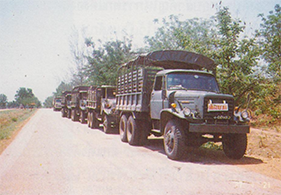
The exterior of the pagoda is decorated with many colors mosaic; gold colour in 210 square meters, triangle shape with brown-gold glass mosaic on 1,100 square meters, surface of inverted-bell shape of pagoda body and edges of 133 arches, curbstone of lower clockwise yard tiled with dark gray glass mosaic on 600 square meters. When we look at the pagoda in the same level, we will see both upper and lower clockwise yard in a bird wing shape. Ceiling of the hall inside pagoda tiled with ivory and pink rose glass mosaic on 220 square meters. All glass mosaic are ordered from Italy. Its qualification is lichens cannot grow on them and it’s easy for cleaning in rain prevail and moist environment.
Outer wall of the pagoda, lower part which shows the 30 perfections, tiled with black granite stone in 340 sq.m.,lower part of inner wall tiled with marble in 170 sq.m. and upper part tiled with Flemish stone in 250 sq.m.
Floor of both clockwise yards (upper and lower one) tiled with marble and granite stone in 1,870 sq.m. Floor inside pagoda’s hall tiled with granite stone in 230 sq.m.
130 stairways to the pagoda and its banister tiled with rough granite stone.
Stone lantern on banister carved from rough stone into round shape. Its diameter is 45 centimeters.
To decorate the pagoda, they are not only using good quality material but also chose beautiful materials, too. Inside pagoda’s hall stated carved granite stone Buddha statue “Blessing Attitude” lap size in 60 inches, 7.3 feet high. This Buddha statue was ordered to carved from Indonesia. There are bas relief granite stone images size 2.4x5.0 meters decorated on 4 sides of the walls inside the pagoda’s hall, showing stories of Buddha’s biography i.e. his birth, his enlightenment, his first sermon and his death. All 4 granite stone images are carved from Ang Sila district, Chonburi province. All arches (6 arches around higher clockwise yard and 7 arches around lower clockwise yard), both sides of arches decorated with bas relief images Dan Kwian artistic style, showing Jataka; 10 reincarnations of Lord Buddha, Himavanta forest and RTAF logo. Along with 4 sides of pagoda’s outer wall also decorated the 4 out of 10 Buddha’s reincarnation stories carved with baked clay tiles Dan Kwian artistic style, too.
They tried so hard to find the best decoration material. Both in architecture and artistic idea. They used only best decoration craftsmen with excellent skill to work for this project because they hope to see this significant bethel will be left to be memorable in this word forever and ever.
When the construction started in late 1986, RTAF had an idea that this pagoda will be a significant bethel that built to dedicate to King Bhumibol showing him delight, joyous and loyalty of Thai people toward him, the supreme commander of Thai Army, who would reach 60 years old. RTAF agreed that this pagoda should get its name from him, so they asked for its name in February 1987.
Asking for the pagoda’s name that time made them look for many words to complete its meaning and elegant. Its meaning concerned in so many levels. In the beginning, Office of His Majesty’s Principal Private Secretary offered 18 names to King Bhumibol for consideration on July 1987 and he said "If we need the words that represent greatness and grandness, From Sky to Earth seems fit for the pagoda’s name"
So The Supreme Patriarch of Thailand contemplated the pagoda’s name and presented to King Bhumibol for consideration.
In the beginning of January 1988, RTAF got letter from Office of His Majesty’s Principal Private Secretary dated January 8, 1988 informed that King Bhumibol has granted the name for the pagoda already which is "The Great Holy Relics Pagoda Nabhamethanidol" means the pagoda that contains Lord Buddha’s great relics which is great from sky to earth.

Not only asking for pagoda’s name, RTAF also asking for his mercy to respectfully engage his short name (Rama IX) under the crown to install in the arches in front of 4 entrances of the pagoda to honor his reputation and royalty widespread and sustainable to be delighted and joyous for Thai people to rejoice with.
So the Great Holy Relics Pagoda Nabhamethanidol which RTAF united to build in occasion of 72 years anniversary to dedicate to King Bhumibol in his 60 years old anniversary in 1987, has occurred at Intanon mountain, Chiang Mai, the highest point in Thailand.
The Buddha Relics
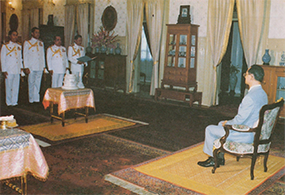

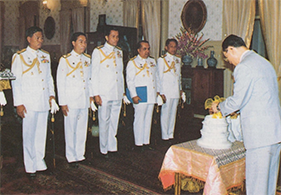
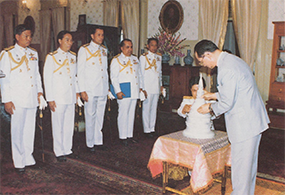








The Buddha relics which contained in the top triangle part of the pagoda (banana blossom shape) decorated with gold glass mosaic which refers to “nirvana”, RTAF has considered seriously about its origin. So they consider about what country that have been kept it carefully for a long time and how they ask to share some of the relics to install in this pagoda. There came the primary considerations that ;
One from asking King Bhumibol
Others from sharing from India and Sri Lanka
In June 1986, RTAF asked Ministry of Foreign Affairs to contact Thailand ambassador at New Delhi and Colombo to contact the government in the countries they work to ask for sharing the Buddha relics to RTAF to respectfully engage it to enshrine at the going-to- be-built pagoda at Intanon Mountain.
Afterwards, in late July 1986, Ministry of Foreign Affairs replied RTAF that Thailand ambassador at New Delhi informed that India government cannot share Buddha relics because they have policy to keep it in India only and they rejected requests from other Buddhist countries before. For Sri Lanka, Mr.Anat Suwannawihok, Thailand ambassador, has contacted the patriarch at Malwatta temple, Siam sect, Kandy and he was pleased to hand over Buddha relics he kept to RTAF around on March 1987.
After RTAF asked for Buddha relics from King Bhumibol to enshrined in the pagoda at Intanon mountain, he has assigned ACM Prapan Thupatemi, RTAF Commander-in- Chief, and senior air force officers to have an audience with him to take Buddha relics on Monday, August 31, 1987 at 04:30 p.m. at Chitralada Villa Royal Residence.
At that time, RTAF offered the exclusive golden casket to the King to put Buddha relics inside. Meanwhile, they also offered 4 exclusive golden caskets which already contain Buddha relics from Sri Lanka, from the Supreme Patriarch, RTAF Commander-in- Chief, air force officers and air force employees, asking the King to put them inside marble pagoda that RTAF will enshrine to the great pagoda later.
Board of Construction are pleased and grateful for having chance to be the King’s audience and received Buddha relics putting into golden caskets for taking to enshrine in the pagoda at Intanon mountain, Chiang Mai according to RTAF purpose to build it for King Bhumibol’s 60 years old anniversary.
Speech of ACM Prapan Thupatemi, RTAF Commander-in- Chief, reporting to King Bhumibol. “By this occasion, I would like to inform Your Highness about this project’s background as follows;
In late 1985s, I got some of Buddha relics and got an idea to build pagoda to contain them. Coincide with in the year 1987, there would be 2 significant auspicious occasion. One is You Highness would reach 60 years old and another one is RTAF would be 72 years. So our senior air force officers and I agreed to build a pagoda to contain Buddha relics and dedicate to Your Highness to represent your reputation and to reinforce your merit, to show Your Highness RTAF officers and members’ loyalty, and to be sign of unity of members of RTAF by this significant occasion.
The process went well. Now there is unfinished job only decoration of the pagoda about 25% left and it will be done within September 15, 1987. About stone Buddha statue which is crafted from Indonesia has been moved to enshrine in the pagoda’s hall already on July 3, 1987.
Estimated budget of this project is about 45 million baht. Received from donation 23 million baht and take from project The Celebrations on the Auspicious of His Majesty the King about 20 million baht.
The Buddha relics which will be enshrined in the top triangle of the pagoda will mainly use from part we take today. The rest we will use the one we took from patriarch Sirimalwatta Ananda, Siam Maha sects, Kandy gave us, from Thailand Supreme Patriarch, from air force officers, from lady Wanida Thupatemi, my wife and from my part, total 5 parts. After RTAF obtain pack of Buddha relics, we will engage it to celebrate in Chiang Mai during September 11-13, 1987. After that we will engage it to be enshrined on the top of the pagoda later.
In this process, RTAF has built 999 small replicated Buddha statues, made from metal. Lap size is 9 inches. 99 of them will be enshrined on the top of pagoda in the same level as Buddha relics. The rest 990 will be enshrined lower, above the pagoda’s ceiling. All stoned Buddha statue and 999 metal Buddha statues will be chanted in Incantation Ceremony inside the pagoda’s hall in September 6, 1987.
RTAF is endless appreciated Your Highness Majesty and great kindness that Your Highness present to Thai people and our institution. Having a chance to build this significant bethel for Your Highness this time is a great merit and it’s because of your protection. Nothing can repay Your Highness better than this. I would like to bless Your Highness long living. I, in the name of RTAF, would like to bow to your feet, obtain your Buddha relics and put them in engaged marble pagoda in order to engage it to celebrate and enshrined in the pagoda consequently.”
These exclusive golden caskets which RTAF made to offer to King Bhumibol to contain Buddha relics are carved his signature. There are 5 layers piled up together, sort from the most inside to outside respectively as follows;
- made out of sandalwood
- made out of ivory
- made out of gold
- made out of pinchbeck
- made out of silver
After King Bhumobol packed them up to the silver layer, then he wrap them with sheer silk cloth and put it into marble pagoda and closes it (the top of the marble pagoda). Then the formality of containing the Buddha relics is done. So there are 7 layers inside that cloth. Then he passes it to ACM Prapan Thupatemi, RTAF Commander-in- Chief.
Building the pagoda is a big deal. It’s morale and encouragement not only for RTAF, but also all Thai people. Board of Construction also can obtain merit. So this is endless mercy of King Bhumibol for RTAF and all Thai people.
Buddha Relics from Sri Lanka When RTAF was informed by Ministry of Foreign Affairs that Mr.Anat Suwannawihok, Thailand ambassador at Colombo (now he is a General Directorate of Department of Protocol) reported that patriarch Sirimalwatta Ananda, Siam sects, Malwatta temple, Kandy is pleased to hand over the Buddha relics and added that this Buddha relics was acquired from a very old temple in Anuradhapura city. It’s a big city in northern part, 206 k.m. away from Colombo. (Kandy is 116 k.m. from Colombo). Anuradhapura city was prosperous. Monk Xuanzang used to visit this city. There is the most ancient sacred Bodhi tree about more than 2,000 years here.
The Patriarch kept and worship this Buddha relics privately at Malwatta temple for a long time. So RTAF arranged plan to take it as follows;
Friday, August 21, 1987, RTAF representative team traveled from Don Muang airport to Colombo.
Saturday, August 22, 1987, traveled from Colombo to Malwatta temple, Kandy and took Buddha relics. Then came back to Colombo.
Sunday, August 23, 1987, RTAF representative team engaged the Buddha relics and travel back from Colombo to the RTAF./p>
Meanwhile, Thailand Supreme Patriarch assigned Prabudhiwongsamuni, dean of Wat Benchamabophit Dusitvanaram temple and primate of north sector, together with Pramaha Tongsoon Rongtong, as representatives of Buddhist monastery to join the team.
There are pictures published about this travel already.
After RTAF team engaged Buddha relics from Sri Lanka to RTAF headquarter, RTAF has put into another golden casket separately and carved its name there. After that they gave it to King Bhumibol, asking him to put it in big golden caskets which made out of pinchbeck and silver respectively.



Thailand Supreme Patriarch, dean of Wat Bowonniwet Vihara temple, mercifully gave Buddha relic to RTAF on August 30, 1987 to be enshrined on the top triangle of the pagoda. RTAF prepared another golden casket for him to put Buddha relics inside and offer them to the King to ask His Majesty to put them into big golden caskets which made out of pinchbeck and silver respectively.

When RTAF assigned representative team to take and engage the Buddha relics from Sri Lanka, they invited Supreme Patriarch from Wat Bowanniwet Vihara temple to put them inside golden casket, appear before loyalty, take it back from the King and put it in marble pagoda already, RTAF has engaged all Buddha relics from headquarter to Chiang Mai by RTAF’s plane on September 1, 1987 at 02:00 p.m.
Engaging Buddha Relics to Chiang Mai : RTAF wanted people in Chiang Mai and nearby provinces come to pay homage and celebrate together for auspicious sign of people in Chiang Mai and northern Thailand.
Celebration started from September 11-13, 1987. Total 3 days 3 nights at Chiang Mai stadium. Chiang Mai Board was a very good co-host.
On September 11, 1987 at 03:00 p.m. when RTAF arrived and engaged Buddha relics to Chiang Mai airport already, Sub Lieutenant Petch Khumsorn, Deputy Governor, the Governor’s representative, along with senior priests in Chiang Mai has entered the plane to worship Buddha relics and engage them to go by car. Car parade left Chiang Mai airport and row up in front of the Three Kings Monument.
When the car parade arrived, Deputy Governor has engaged Buddha relics to be enshrined on a royal chariot which was in the formed procession, ready to move through the roads to Chiang Mai stadium.
Deputy Governor lighted up gold ornament in front of the monument, engaged spirits of all Three Kings to worship Buddha relics. Until around 03:30 p.m. the parade moved to Chiang Mai stadium. This parade consisted of bunting flag parade, boy students marching band, girl students marching band, students parade, parade of Buddhist Association, parade of Young Buddhist Association, parade of Air Force officers dressed with white uniform, parade of royal chariot which included air force officers, Thai Volunteer Defense Corps (TVDC), civil boy scouts, students, collegians assisted dragging the parade along the road. When they arrived the stadium, Deputy Governor has engaged the Buddha relics to enshrined at site of the rite while Buddhist monks were chanting Jayamangala Gāthā (the eight victories and blessing).
After that, Buddhist ritual continued, 10 monks chanted Buddha stanza to celebrate Buddha relics.
RTAF and Chiang Mai government let people come to worship Buddha relics for 3 days 3 nights. There was entertainment at night i.e. music band from RTAF, outdoor movies. There were plenty people came to worship. There was a miraculous for the Board and other senior officers in Chiang Mai that before the celebration started, it rained in the evening every day. But during 3 days of celebration, there was heavy rain. There was only rain mist just like a monk sprinkling holy water to people at some night. But in the last night of celebration, September 13, 1987, around 02:00 a.m., it was continuous downpour and windy just like angle pouring water down there. So there was flood within Chiang Mai stadium and nearby roads. Some said there never be like this before. It rained like someone wanted to clean Chiang Mai because late in the morning of September 14, 1987, flooding already gone.
May this incidence be a sign of prosperity and peace of people in Chiang Mai and in northern Thailand.
September 14, 1987, around 07:30 p.m. was the schedule to engage Buddha relics from Chiang Mai stadium before dawn and set up car parade for ACM Prapan Thupatemi, Lady Wanida Thupatemi with senior government officers to engage Buddha relics from Chiang Mai city area along Chiang Mai-Chomtong road.
At a few moments before 07:00 a.m., RTAF Commander-in- Chief and fellows have reached the pagoda. They help one another to lift palanquin which laid the Buddha relics and walked along 126 steps of pagoda’s stairways and entered the pagoda’s hall. Meanwhile, Buddhist monks were chanting Jayamangala Gāthā. Then they waited for the time to enshrine Buddha relics to the top triangle of the pagoda.
At night of September 13, 1987, rain did not pour only in Chiang Mai city area, but it downpoured widespread. There was obviously flood and flowed from hills to plain. It was flooded along Chiang Mai-Chomtong road. Some phase, the road was submerged, or some trees broke down and blocked the road. But this cannot stop the parade to move to Intanon Mountain. The night before, there was lightning during heavy downpour and hit the transformer which supply electricity along this road and supply the tower crane which was using in the pagoda project. This tower crane was planned to transport Buddha relics to the top of the pagoda. When it was blackout, the staffs tried to fix it to get back to work on time. This time ACM Prapan Thupatemi wanted to go along with the crane to enshrine Buddha relics by himself, too. When there was no power, they canceled hoisting the crane and using sling engaged Buddha relics to the top of the pagoda and they had soldiers passed them hand to hand along the scaffolds and arranged them one by one around the pagoda.
At 07:19 a.m., officiated packing up Buddha relics. ACM Prapan Thupatemi, RTAF Commander-in- Chief, has engaged Buddha relics from pagoda’s hall to pack them up by started passing them hand to hand. 10 monks chanted Jayamangala Gāthā. Buddha relics were enshrined by manpower with merit minded, no machinery used at all.
To enshrine Buddha relics on a 50-meter- high pagoda on high mountain like this, RTAF has considered over and over. In the beginning, they thought they will invite King Bhumibol to pack up Buddha relics here but the worried that during enshrining process, all scaffolds must still be installed on the pagoda which would look untidy. Moreover, there might be windy or rain during ceremony which is risky for hoisting Buddha relics to the top of pagoda. So RTAF does not want to risk it and chose to ask the King to pack up Buddha relics at Chitralada Villa Royal Residence instead and enshrine them to the top of pagoda by themselves. Now the ceremony is done.


